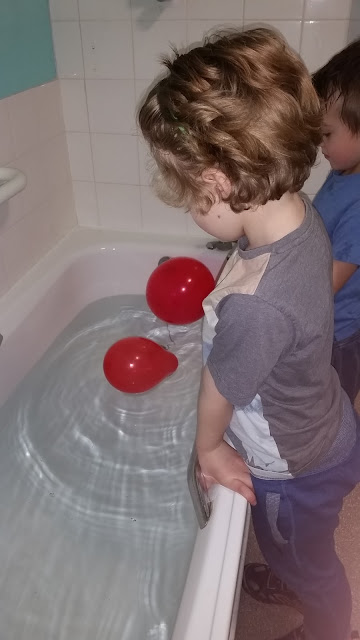One type that they seemed very keen on investigating were the different types of boats. We are lucky to live near the Chatham Maritime Dockyard so can experience the different types of boats through the ages.
On our regular visits we get to see many different types of boats and ships made from different materials, all with a different purpose. This, obviously, brought up a lot of questions from the boys to why the different materials were used and how each of them would float; subsequently, we decided to see what would and wouldn't float before we made our own.
- To discover which materials to use when making a boat
The first type of items the boys suggested would float were footballs and balls (they meant buoys here) ; their logic stated that they were filled with air so the would float. We were lucky to have some balloons left from William's birthday to give this theory a go.
We then discussed the fact that the air is lighter than the water displaced and if enough force was added then it would, whilst at that pressure or weight, sink.
The boys found this interesting but they also understood that some of the big ships were made of metal and they assumed the weight of metal would mean that it would sink.
Out came our baking trays to give it a go.
Initially, each tray that was placed was thin and wide so continued to float. James really wasn't happy with this, his logic said metal is heavy, metal would and should sink; William understood though that the surface area was wider and spread across the water enough compared to its weight.
As you can see below, James decided to stack all of the metal trays on top of each other to increase the weight to make it sink. Between the two of them they actually tried stacking the trays in a different order to see if it made a difference; they found that the larger trays on the bottom stayed above the water and with that they understood about the area of the object was important.
William questioned about boats made of fiberglass and came up with a solution to test at home. We had already discussed the fact the fiberglass was woven and layered strands; similar to clothes but made of glass.
He proposed that cardboard boxes, specifically an egg box, would work; he thought that cardboard is just layered paper and should float.
I, admittedly, was sceptical with the assumption and tried to explain that it would become too wet, too quickly and would sink; I was wrong.
It actually stayed afloat and only lost it's structural integrity when it was fully immersed in water. This was interesting for our experiment as they both decided that for longevity that cardboard boats wouldn't be a good idea. William did see that something more durable like fiberglass would last longer.
We had discussed Lifeboats as we saw a few and new that some of the newer designs were made out of plastic. With this in mind the boys tried and tested plastic bottles to see if they would float too.
The next challenge was to see if each individual material would balance a cup of water or if that failed to see if a combination of them would work.
James found that the larger metal trays would hold a cup but the best shape was the bread tin. He actually compared the sides of the tin to a boat and felt that this would work in his favour.
William was immediately more adventurous. As you can see in the above photo that he placed a metal tray upon two bottles and managed to float a full cup of water on top.
However, as you can now see, it didn't last long! William's diagnosis.........we need string to tie them together!
I absolutely loved doing this with the boys and hearing about their different ideas to what would and wouldn't float.
They both showed good understanding and explored, in depth, each component.
Their overall view for making a boat came in 2 conclusions:
- It needs to be solid and large
- It need to be made of materials that float naturally like plastic bottles.
On to making the boats!









No comments:
Post a Comment